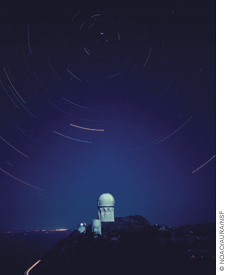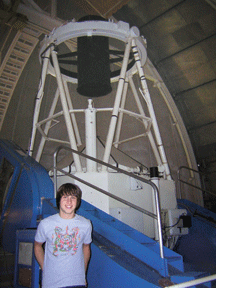
On a gray day during the middle of finals last December, junior Thomas Krane walked out of a professor’s office on the second floor of the David Rittenhouse Laboratories. Days away from a seemingly impossible exam and plowing through the hardest semester he’d experienced so far, Thomas hadn’t showered in two days. (“Which is a lot for me!” he remarks.) He scrolled through his Blackberry, checking emails. Amid messages from study groups and fraternity brothers, there was one email Krane had been waiting months for. It was from the National Optical Astronomy Observatory (NOAO) proposal committee.
After 18 months of research, two proposals, and one rejection, Krane had been granted four nights of telescope time at the prestigious Kitt Peak observatory in Arizona’s Sonoran Desert. He was the first undergraduate in the country to be named principal investigator on a study of this kind.

That day in DRL, Krane forwarded the email to his professor and co-investigator on the project, Masao Sako, adding, “We got in!” followed by dozens of exclamation points.
Dashing off that note somehow didn’t feel sufficient. “Right after I emailed him I ran into his office and burst in saying, ‘We got the time! We got the time!’” Krane remembers. “I must have looked like a madman.”
The 21-year old from Pacific Palisades, California has light brown hair cut in a surfer shag and his wardrobe is a revolving set of graphic tees. His peers know him as a member of popular campus band Slow Dance Chubby. Few of his close friends know about his scientific prowess.
Krane began researching with Sako, an assistant professor of physics and astronomy, the summer after his freshman year at Penn.
Sako was working on a project with John Peterson, a Purdue University professor he met during PhD studies at Columbia University. They aimed to discover new clusters of galaxies, and enlisted Krane to join the team.
“Clusters of galaxies are the most massive structures in our universe,” Krane explains. “Most galaxies are clustered together and are gravitationally bound. They’re interesting because they tell you a lot about how the structure of the universe is laid out.”
Sako had a list of about 700 potential clusters of galaxies drawn from unanalyzed X-ray telescope data logged by various researchers who were focused on different questions. About half of those potential clusters, if verified, would represent new discoveries. The idea was to compare a subset of those with archival optical data and find out.
“My job was to sift through the data and figure out what looked like it might be a cluster,” Krane says.
But data from scientific catalogs weren’t enough.
“At the end of the summer,” Krane recalls, “Masao told me, ‘There’s only so much we can do with the archival data. The next step is to get our own observation.’ He told me I should write a proposal to get time on a telescope.” So he did.
“To be honest,” Sako says, “I didn’t really think the first proposal would go through the review panel … It sounded like a proposal that maybe a graduate student wrote. It’s pretty competitive.”
“There’s not even a template for undergrads on the application form,” Krane says. “That was kind of cool.”
Krane came back to Penn in the fall of his junior year to write a new proposal.
“Masao kept throwing a bunch of different ideas at me, like how to make it more interesting. One was to compare catalogs [of galaxy clusters] and see what they look like against each other.” That idea stuck.
Krane began comparing his cluster candidates to the MaxBCG cluster catalog. The MaxBCG is an automated algorithm that scrutinizes images from the Sloan Small Digital Sky Survey to flag galaxy clusters. Krane found that many of the cluster candidates he’d identified weren’t in the MaxBCG catalog. With images of these specific galaxy clusters from telescopes at Kitt Peak, Krane could prove that there might be something systematically wrong with MaxBCG’s search algorithm.
“It might not be as complete as they think,” Krane explains. “So that’s interesting.”
The NOAO agreed, and approved his second proposal.
Krane, Sako, and Peterson arrived at Kitt Peak in mid-May, the day after he finished his spring semester.
For the next four days, Krane and his mentors slept during the day in adjacent dormitories, ate meals in a cafeteria, and caught views of what Krane dubs “an amusement park for astrophysicists.” From 8:30 p.m. until dawn, they sat in a control room operating a two-meter telescope, capturing images they hoped would prove their claim.
The trip to Kitt Peak was successful. “We found about seven or eight newly discovered galaxies that should have been in this MaxBCG catalog but aren’t,” Krane says.
The observation was originally for his senior thesis, but now he has the chance to publish the discovery in an academic science journal.
“If he can turn this into a reference article, he can pretty much get into any graduate school,” Sako says matter-of-factly.
Krane is already venturing into graduate studies. Upon returning from Kitt Peak, Sako nominated him to be a Vagelos Challenge Scholar, an award designed for promising undergraduates at Penn who study science. The scholarship foots the tuition bill for recipients to earn a master’s degree in their senior year. Sako submitted Krane’s name to a review board, and mere hours later he was notified that he’d been named a Challenge Scholar.
“I don’t think there are any other undergraduate students that have similar research experience,” Sako says with pride. “I think it was an easy decision.”
“It’s hard to understand the magnitude Masao has helped me,” Krane says. “He’ll say it was all me, but nothing would have happened without him.”
But Krane’s future might not be filled with long nights in telescope control rooms. This summer, he headed to New York to intern at a venture capital firm, a position he earned through the Wharton-driven on-campus recruiting program.
“I came to Penn knowing I wanted to study physics,” Krane says. “But I don’t think I’m defined by my interest in science. I owed it to myself to try something non-science.”
In the fall, Krane will analyze his conclusions from Kitt Peak, complete his honor’s thesis, pick up four graduate level courses, and begin writing his first scientific article. Past that, his plans are uncertain.
“Masao told me every step of his post-graduate studies, he was unsure,” Krane remarks. “That was reassuring. He said he wanted to open a restaurant.”
Krane throws up his arms. “I want to follow whatever I like the most. What that will be, I’m not sure.”
—Jessica Goodman C’12




